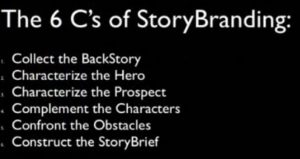Reinvention Summit 2 is history, but I’m continuing to recap, synthesize, and expand on its 20 excellent sessions.
Because I’ve published some of author Jim Signorelli’s approaches in my  Q&A and because even more is available in a meaty excerpt from his book, StoryBranding, I won’t go into great detail about his excellent session. By the way, Reinvention Summit founder Michael Margolis called StoryBranding the definitive book on story and branding.
Q&A and because even more is available in a meaty excerpt from his book, StoryBranding, I won’t go into great detail about his excellent session. By the way, Reinvention Summit founder Michael Margolis called StoryBranding the definitive book on story and branding.
Two things especially got my attention. Because storytelling in job search and career is my special niche, I loved hearing Jim say, “The [job applicants] that make it for me are the ones that come in with stories.” Jim wants them to respond to job-interview questions by telling a story — something that happened to them that demonstrates what they believe in.
The other thing that intrigued me big time was Jim’s statement that he’d like to look at how to apply his StoryBranding model to personal identity. That really got my attention because personal identity and branding are so important and because I’ve yet to come across a method for developing and personal brand that truly resonates with me. I like bits and pieces of several approaches, but no one technique has resulted in an “aha” moment for me yet.
Any attempt to spell out what Jim’s would include is pure conjecture on my part, but we can probably assume it will look something like his 6 Cs of StoryBranding (see slide below).
 Collecting the back story is certainly a familiar concept, one that Michael Margolis himself teaches, as I wrote about here.
Collecting the back story is certainly a familiar concept, one that Michael Margolis himself teaches, as I wrote about here.
Thinking of ourselves as heroes, let alone characters, may be a new idea for some. I would not be surprised to see Jim use the idea of archetypes here, since he uses The [Carol] Pearson Archetypal System with the other brands he works with. You can get a head start toward identifying the archetype you most relate to with the assessment instrument on Cindy Atlee’s site.
Jim says that “Characterize your prospect” is about identifying potential needs that the brand can appeal to with potential customers. For an individual, your customer could be an employer or a particular client base (if you’re an entrepreneur). What need does that audience have that you could fulfill? What problem(s) could you solve?
I believe Complement the Characters means finding the fit between the individual’s values and beliefs and the target audience’s. For job-seekers and entrepreneurs alike, solid research can reveal the prospective employers or clients that are the best fit with you.
In Jim’s model, obstacles include awareness, comprehension, confidence, and affinity, which need to be addressed to fully connect with customers. How can you make the employer/client aware of you, comprehend you, have confidence in you? How can you develop an affinity between you and the employer/client?
Jim’s Story Brief is a little more complex and involves inner and outer layers. I think it can apply to individuals, but maybe it needs to be tweaked a bit. I need to learn more.
Again, I’m purely guessing here, so I will be extremely eager to see Jim’s concepts for StoryBranding for personal identity/branding develop.
One (of probably many) other concept that fits the individual is Jim’s idea of “authoring” a brand vs. selling it. We’re authors of our own lives, not sellers of them.
